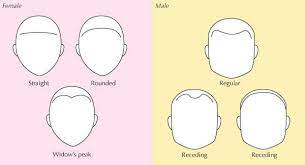
Many factors can contribute to receding hairlines, from genetics and aging to lifestyle factors like certain hairstyles or stress. Receding hairlines may appear as a straight line across the forehead, an “M” shape leading to a widow’s peak, or be distorted by cowlicks.
Genetics
Men with receding hairline typically experience a gradual loss of front-area hair and an increase above their temple region, known as male pattern baldness. This condition tends to worsen with age.
Genetics plays a significant role in receding hairlines, though it’s not the sole factor responsible. Consulting with a dermatologist can help find the most effective treatment option, which may include tests such as pull tests or biopsies on your scalp.
Hormones
Hormonal shifts or age-related factors like DHT levels in the body can contribute to receding hairlines in men. Certain medications, including chemotherapy treatments, may also cause hair loss.
Natural solutions like essential oils (peppermint, tea tree, rosemary, thyme, and lavender) have been shown to encourage hair growth and reduce hair loss. Low-level light therapy is also an adequate remedy.
Stress
Stressful situations can accelerate hair loss, and managing stress is necessary to minimize its impact. Exercise, outdoor time, and relaxation techniques like meditation can help.
Receding hairlines are common in both men and women. They can result from factors such as male pattern baldness or frontal fibrosing alopecia. Discussing available options with a trichologist or dermatologist is crucial to determining the best course of action.
Styling
Men with receding hairlines can still look their best by selecting a style that maximizes scalp coverage. Growing out long locks or wearing curls for casual looks can be effective.
A crew cut, featuring close-cropped sides that gradually get longer toward the top of the head, is another excellent option for men with receding hairlines.
hair Dyes
Hair colors that match skin tones more effectively can help conceal receding hairlines and thinning locks, making it harder to detect bare scalp areas.
Recession of the hairline does not necessarily indicate future baldness, but it can be an early indicator. Treatments are available to reduce or reverse hair loss.
Pregnancy
hair loss can affect anyone, regardless of age or gender. Women, too, can experience receding hairlines called frontal fibrosing alopecia.
No matter the cause of your receding hairline, various treatments are available to address it. Consultation with a physician or specialist will provide insights into all available solutions.

